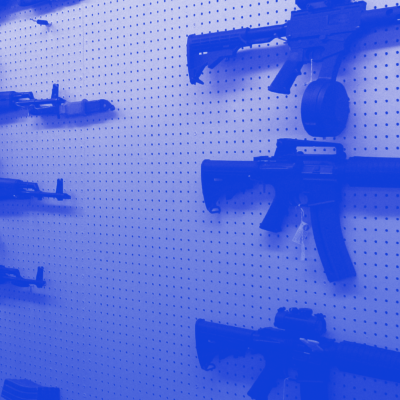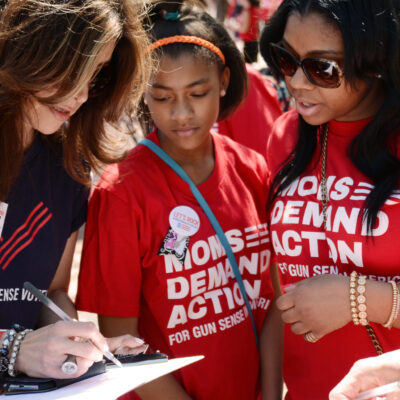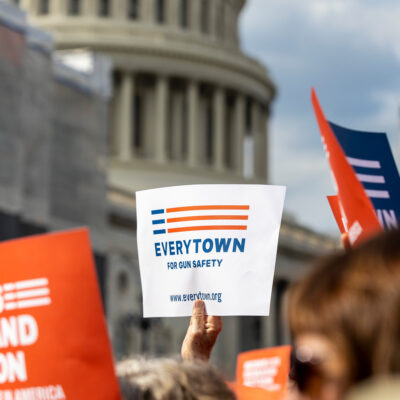Stop Arming Teachers
What does it solve?
To prevent tragedies we must implement strong school safety solutions, but arming teachers is not one of them. School shootings are chaotic and in these moments of chaos, we cannot ask teachers to stop a shooter, potentially a current or former student.
Having guns in the classroom increases the likelihood that a student will access a gun and that someone will be shot outside of an active shooter incident. Schools are places for books and backpacks, not weapons. Instead, we need proven solutions that are backed by data, and that intervene before violence occurs.
Which states don’t allow teachers or the general public to carry guns in K–12 schools?
The states in white allow teachers or the general public to carry guns in K–12 schools, and those shaded in blue do not allow them to do so.
No Guns in K-12 Schools
Alabama has adopted this policy
No Guns in K-12 Schools
Alaska has adopted this policy
No Guns in K-12 Schools
Arizona has adopted this policy
No Guns in K-12 Schools
Arkansas has not adopted this policy
- If not, who is allowed to carry under state law?
- Permit holders aged 19 or older
No Guns in K-12 Schools
California has adopted this policy
No Guns in K-12 Schools
Colorado has adopted this policy
No Guns in K-12 Schools
Connecticut has adopted this policy
No Guns in K-12 Schools
Delaware has adopted this policy
No Guns in K-12 Schools
Florida has not adopted this policy
- If not, who is allowed to carry under state law?
- School personnel
No Guns in K-12 Schools
Georgia has not adopted this policy
- If not, who is allowed to carry under state law?
- School personnel
No Guns in K-12 Schools
Hawaii has adopted this policy
No Guns in K-12 Schools
Idaho has adopted this policy
No Guns in K-12 Schools
Illinois has adopted this policy
No Guns in K-12 Schools
Indiana has adopted this policy
No Guns in K-12 Schools
Iowa has not adopted this policy
- If not, who is allowed to carry under state law?
- School employees
No Guns in K-12 Schools
Kansas has not adopted this policy
- If not, who is allowed to carry under state law?
- School personnel and any other permit holders
No Guns in K-12 Schools
Kentucky has adopted this policy
No Guns in K-12 Schools
Louisiana has adopted this policy
No Guns in K-12 Schools
Maine has adopted this policy
No Guns in K-12 Schools
Maryland has adopted this policy
No Guns in K-12 Schools
Massachusetts has adopted this policy
No Guns in K-12 Schools
Michigan has adopted this policy
No Guns in K-12 Schools
Minnesota has adopted this policy
No Guns in K-12 Schools
Mississippi has not adopted this policy
- If not, who is allowed to carry under state law?
- Any permit holders; School personnel
No Guns in K-12 Schools
Missouri has not adopted this policy
- If not, who is allowed to carry under state law?
- School personnel
No Guns in K-12 Schools
Montana has adopted this policy
No Guns in K-12 Schools
Nebraska has adopted this policy
No Guns in K-12 Schools
Nevada has adopted this policy
No Guns in K-12 Schools
New Hampshire has not adopted this policy
- If not, who is allowed to carry under state law?
- Any permit holders
No Guns in K-12 Schools
New Jersey has adopted this policy
No Guns in K-12 Schools
New Mexico has adopted this policy
No Guns in K-12 Schools
New York has adopted this policy
No Guns in K-12 Schools
North Carolina has adopted this policy
No Guns in K-12 Schools
North Dakota has not adopted this policy
- If not, who is allowed to carry under state law?
- School personnel
No Guns in K-12 Schools
Ohio has not adopted this policy
- If not, who is allowed to carry under state law?
- Individuals with written authorization of the board of education or governing body, including teachers
No Guns in K-12 Schools
Oklahoma has not adopted this policy
- If not, who is allowed to carry under state law?
- School personnel
No Guns in K-12 Schools
Oregon has not adopted this policy
- If not, who is allowed to carry under state law?
- Any permit holders
No Guns in K-12 Schools
Pennsylvania has adopted this policy
No Guns in K-12 Schools
Rhode Island has adopted this policy
No Guns in K-12 Schools
South Carolina has adopted this policy
No Guns in K-12 Schools
South Dakota has not adopted this policy
- If not, who is allowed to carry under state law?
- School personnel
No Guns in K-12 Schools
Tennessee has not adopted this policy
- If not, who is allowed to carry under state law?
- School personnel
No Guns in K-12 Schools
Texas has not adopted this policy
- If not, who is allowed to carry under state law?
- School personnel
No Guns in K-12 Schools
Utah has not adopted this policy
- If not, who is allowed to carry under state law?
- Any permit holders; teachers
No Guns in K-12 Schools
Vermont has adopted this policy
No Guns in K-12 Schools
Virginia has adopted this policy
No Guns in K-12 Schools
Washington has adopted this policy
No Guns in K-12 Schools
West Virginia has adopted this policy
No Guns in K-12 Schools
Wisconsin has adopted this policy
No Guns in K-12 Schools
Wyoming has not adopted this policy
- If not, who is allowed to carry under state law?
- School personnel
Myth & Fact
Myth
Armed teachers would keep schools safe.
Fact
There are good reasons why arming teachers is opposed by school safety experts, teachers, and law enforcement. First, when a gun is in the classroom, students can get access to it. There have been multiple incidents of students and teachers finding misplaced firearms: in bathrooms, locker rooms, and even sporting events.1 Kelly Drane, “Every Incident of Mishandled Guns in Schools,” Giffords Law Center, April 7, 2023, https://giffords.org/report/every-incident-of-mishandled-guns-in-schools/. The notion of a highly trained teacher armed with a gun, able to respond as quickly as trained law enforcement is a myth. Law enforcement officers receive hundreds of hours of training but in states that have laws to arm school personnel, school staff receive much less training.2Greg Toppo, “132 Hours To Train Teachers On Guns: Is It Enough?” USA Today, March 8, 2018, https://www.usatoday.com/story/news/2018/03/08/132-hours-train-teachers-guns-enough/408525002/.
How it works
Armed teachers are not the answer to school violence.
There is a false idea that arming teachers and school staff will make our schools safe. In fact, an armed teacher cannot, in a moment of extreme duress and confusion, be expected to transform into a specially trained law enforcement officer. Even some of the most highly trained law enforcement officers in the country see their ability to shoot accurately decrease significantly when engaged in gunfights with perpetrators.1Bernard D. Rostker et al., “Evaluation of the New York City Police Department Firearm Training and Firearm-Discharge Review Process,” RAND Corporation, 2008, https://bit.ly/2U9bk0t. An armed teacher is more likely to impede responding law enforcement than to stop an active shooter in a school.2National Association of School Resource Officers, “NASRO Opposes Arming Teachers,” February 22, 2018, https://www.nasro.org/news/2018/02/22/news-releases/nasro-opposes-arming-teachers/.
Our leaders should instead pursue evidence-based interventions, for example: Extreme Risk laws can stop people who show warning signs of danger to themselves or others from accessing and buying guns. Secure storage awareness can address the most common source of guns used in school gun violence—those taken from home. And schools can invest in mental health professionals and create crisis intervention programs that identify and intervene when a student is a risk to themselves or others.
By the numbers
76%
76 percent of surveyed pre-K–12 educators oppose arming teachers and staff in public schools.
63%




